Yves here. Readers will in many cases be correctly skeptical of geoengineering schemes, particularly since many have a nasty habit of exaggerating their effectiveness and not including the energy cost of implementation. And that’s before getting to not adequately recognized side effects.
Nevertheless, this article provides a useful tally of geoengineering methods. It also towards the end list some that should be uncontroversial, like painting roofs white and mixing more cheap white reflexive material into road materials. I recall reading in a Wall Street op ed around 2005 (which of course given the state of search I have never been able to find) advocated those methods and argued if employed widely, they alone would make a dent in the pace of global warming (we really do have that many rooftops and paved surfaces…).
By Josh Owens, the Content Director at Oilprice.com. Originally published at OilPrice
- As the world struggles to balance both energy security and emissions reduction, debates around the role of geoengineering in the global energy transition are heating up.
- The first type of intervention is carbon dioxide removal, with approaches including carbon capture, bioenergy, and ocean geoengineering.
- The second and more controversial type of intervention is solar radiation management, which includes aerosol injection, cloud brightening, and even space mirrors.
It increasingly feels like we are nearing an inflection point when it comes to energy consumption, production, and the combatting of climate change.
On the one hand, new temperature records are being set around the world, environmental movements are gaining traction, and governments are pursuing steadily more aggressive emission reduction policies.
On the other hand, renewed geopolitical instability, underinvestment in fossil fuel production, and a global rebound in energy demand after the pandemic have sent prices soaring and put energy security back into the limelight.
Balancing these two factors – energy security and emissions reduction – promises to be the central challenge for the global energy industry going forward as the world attempts to map out an energy transition.
In the meantime, the debate around different forms of geoengineering is intensifying, with some seeing it as a dangerous distraction while others insist it is the only viable path forward to counter climate change.
The truth, as usual, lies somewhere in between. Each method of geoengineering has pros and cons, and any attempt at finding the optimal path to emissions reduction will be undermined by efforts either to exaggerate the threat geoengineering poses or overstate its potential.
What Is Geoengineering?
Geoengineering refers to deliberate, large-scale interventions in Earth’s natural systems to counteract climate change or mitigate its effects. These interventions are broadly divided into two groups, carbon dioxide removal (CDR) and solar radiation management (SRM).
The first of these, CDR, is focused on removing carbon dioxide from the atmosphere in order to reduce the amount of solar heat that is trapped in Earth’s atmosphere via the ‘greenhouse effect’. Popular methods of carbon dioxide removal include carbon capture and storage, ocean geoengineering, afforestation, and enhanced rock weathering.
The second type of intervention, SRM, is designed to reflect a portion of the sun’s energy away from Earth, thereby reducing the amount of solar heat that can be trapped in the atmosphere. Solar radiation management techniques include injecting aerosols into the stratosphere, ‘brightening’ clouds, and even placing reflective surfaces in space to reduce the amount of sunlight reaching Earth.
Perhaps unsurprisingly, it is this second method that is generally deemed the most controversial form of geoengineering, with the first method attracting far more attention and investment.
Carbon Dioxide Removal
In recent years, as pressure to decarbonize has climbed, carbon dioxide removal has well and truly gone mainstream. The six most prominent methods are carbon capture utilization and storage, direct air capture, bioengineering with carbon capture and storage, ocean geoengineering, afforestation, and enhanced rock weathering.
While each of these methods faces its own unique challenges, the unifying problems for all of them are scalability and cost. In 2023, global CO2 emissions are set to climb to 40.9 gigatons (Gt CO2). To put that in perspective, a study released in January 2023 suggested that just 2 Gt CO2 was being removed from the atmosphere each year and only a minuscule fraction of that (0.002 Gt CO2) came from novel technologies and methods. The vast majority of current carbon removal is done by the world’s forests and oceans.
With that in mind, here is a brief overview of the main approaches and their potential.
Carbon Capture, Utilization, and Storage (CCUS)
Carbon Capture, Utilization, and Storage (CCUS) is a method of carbon removal that has been around for decades, but in recent years its development has accelerated dramatically. In CCUS, CO2 is captured directly at a power station, industrial plant, or other high-emission site and either used in another process or transported to a storage site.
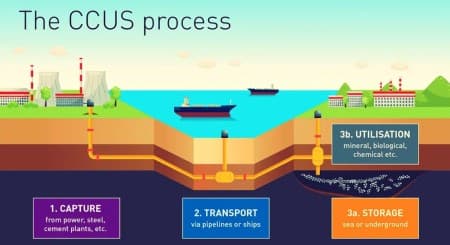
Source: Carbon Credits
The captured carbon can then be used in the production of plastics, concrete, or efuels. Interestingly, the same characteristic that makes plastic a nightmare when it comes to pollution – namely that it is so difficult to break down – means that it is a very effective way to store carbon. Technically, making plastic from carbon capture could be a carbon-negative process.
Within the oil and gas industry, enhanced oil recovery (EOR) is the most common form of CCUS. By injecting captured carbon dioxide into existing oil wells, companies can extract an additional 30 to 60 percent of the reservoir’s original oil in place while effectively storing the carbon underground. Critics of this technique point out that it results in an increase in oil production which could ultimately mean more emissions rather than less. The upsides, however, can include a reduction in flaring, increased demand for captured carbon dioxide, and ultimately fewer oil wells being drilled.
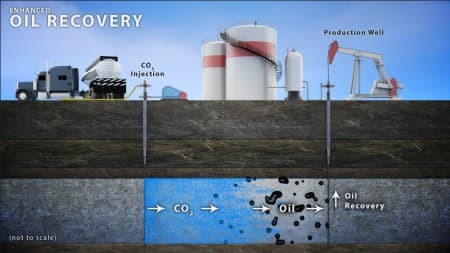
Source: National Energy Technology Laboratory
According to McKinsey analysis, the global capacity of CCUS needs to climb to 4.2 Gt CO2 by 2050 for countries to achieve their net-zero commitments. Currently, there are 40 commercial capture facilities in operation globally, with a total annual capture capacity of around 45?Mt CO2.
Direct Air Capture
Direct Air Capture (DAC) has the potential to not only reduce carbon emissions but to reduce the total amount of carbon in the atmosphere. The process involves using renewable energy to extract carbon dioxide directly from the air and then store it deep underground.
With carbon dioxide making up just 0.04% of the Earth’s atmosphere, the major challenge for DAC is the volume of air that must pass through the system to remove any significant amount of CO2. This makes direct air capture very energy-intensive and very expensive.
A major advantage for DAC plants is that they are not limited by location, meaning they can be built wherever there is an excess of clean or low-carbon energy. With that said, further testing is needed to confirm the efficacy of this technology in extremely dry or humid climates.
The largest DAC plant currently in operation is Climeworks’ Orca plant, which uses geothermal energy to remove 4000 tonnes of CO2 per year.
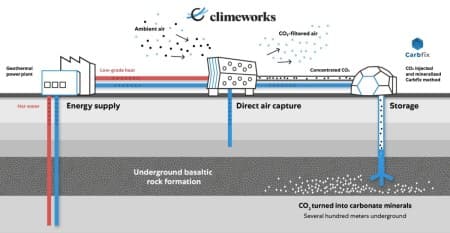
Source: Climeworks
The 27 DAC plants that have been commissioned to date worldwide capture around 0.01?MtCO2 per year. In the IEA’s Net Zero Emissions by 2050 Scenario, DAC capacity would need to climb to 1.2 GtCO2 per year. With 130 DAC facilities now at various stages of development, and with projects having a lead time of two to six years, that target is technically achievable but would require heavy investment and a significant reduction in the cost of the technology.
Bioenergy with Carbon Capture and Storage (BECCS)
Bioenergy with carbon capture and storage (BECCS) is another CDR method that has the potential to have net negative emissions, it is also the only method that also produces energy. This process uses biomass to create energy and then stores the CO2 emitted in the process of burning the biomass.
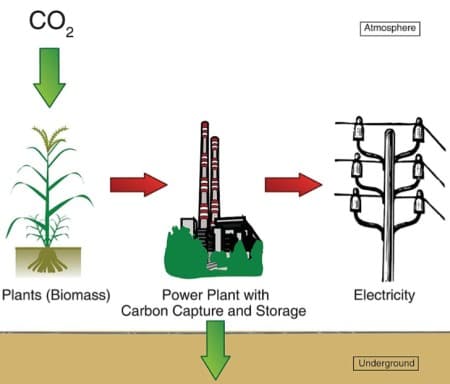
By far the most common form of bioenergy being used today is bioethanol, which acts as a fuel and can be blended with gasoline. Of the 2 Mt CO2 of biogenic sources being captured annually, bioethanol accounts for 90% of it. Less than half of that captured CO2 is currently being stored in dedicated storage, with the rest being used in processes like enhanced oil recovery or yield boosting in greenhouses.
As well as fuel, bioenergy can be used for industry, power, and heating. Recently announced BECCS projects includeheat and power plants in Denmark, cement plants using biomass feedstock in Norway and Sweden, pulp and paper mills looking to use bioenergy in Canada, and even hydrogen facilities.
By 2030, carbon removal via BECCS could climb to just under 50 Mt CO2 per year based on current plans, well below the IEA’s target of 190 Mt CO2. In that target, biofuels would be removing 130 Mt CO2, the power sector would be removing 40 Mt CO2, and industry would be removing 20 Mt CO2.
The two main concerns for BECCS include the amount of land used to grow the biomass and the potential of leaks of carbon dioxide throughout the system. This approach also faces significant cost and scalability challenges.
Ocean Geoengineering
Of all the carbon stored on Earth, the vast majority of it can be found in the ocean. While the air holds 875 billion tons of carbon and land holds 3.5 trillion tons of carbon, the ocean holds a remarkable 40 trillion tons of carbon.
Ocean geoengineering is the attempt to boost the ocean’s capacity to hold carbon through one of two methods. The first method involves cultivating ocean life to increase the amount of carbon that ultimately ends up in ocean forests or on the seafloor. The second method involves altering the composition of the ocean itself so that the seawater can hold more carbon.
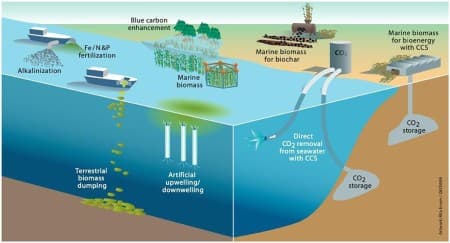
Source: frontiersin.org
The first of these methods focuses on altering ocean ecosystems to ensure more carbon ends up on the seafloor. One example of this method is ocean fertilization, which involves adding nutrients to the surface of the ocean in an attempt to boost phytoplankton, the phytoplankton then absorb carbon dioxide from the atmosphere, are eaten by fish, and the carbon ends up on the sea floor. Perhaps the most well-known project is the one being led by David King, former chief scientific adviser to the UK government, which aims to stimulate phytoplankton with artificial whale poo.
The second method, which is an increasingly popular field of study, involves altering the chemical composition of seawater to boost its carbon uptake. When carbon dioxide in the atmosphere dissolves in seawater, it is converted into carbonic acid. Carbonic acid then reacts with carbonate in the ocean to form bicarbonate which traps the carbon in a stable form. As carbon dioxide levels in the atmosphere have risen, the world’s oceans have absorbed more and more carbon, decreasing the concentration of carbonate and increasing the acidity of the ocean. By adding alkalinity to the ocean, scientists hope to reverse this trend and, in doing so, increase the ability of seawater to absorb more carbon dioxide.
The main issue facing ocean geoengineering is the same one that the SRM techniques looked at below have to deal with. The size of the intervention required means that we will have very little ability to accurately measure it or fully understand its consequences. It would also need international governance due to the interconnected nature of the world’s oceans. Proponents of this approach claim that we are already intervening in the ocean by increasing its acidity and have a responsibility to reverse or limit those changes.
Afforestation
Planting trees is perhaps the most well-known form of carbon sequestration and is not normally associated with geoengineering. Afforestation is the one form of tree planting that can be considered geoengineering as it involves establishing a forest in an otherwise treeless environment.
Afforestation has been taking place around the world for decades and for a variety of reasons. In 1935 under FDR’s New Deal, the Prairie States Forestry Project saw the planting of millions of trees from Texas up to Canada in order to counter soil erosion and unemployment. In China, the Three-North Shelter Forest Program, which was started in 1972, was designed to halt desertification and hold back the expansion of the Gobi desert. Similarly, in 2007, Africa’s Great Green Wall was launched as an attempt to hold back the Sahara desert by planting trees from Djibouti to Senegal.
Now, as efforts to boost carbon dioxide removal grow, afforestation is gaining attention as a potential tool for countering climate change. A 2019 study published in the journal Science suggests there is potential for a further 0.9 billion hectares of forest on earth, representing a 25% increase in forested area and an additional 200 Gt of sequestered carbon.
As with all CDR methods, afforestation has its drawbacks and uncertainties. Firstly, if carried out on the wrong land or with the wrong trees, it can damage local ecosystems and drain areas of water. There are also questions of cost and land use, especially when you consider it can take a century for forests to reach maturity. Finally, it remains unclear how the climate will react to massive global afforestation efforts, especially considering the albedo changes which could have a warming effect on the planet (something we will touch on again below).
Enhanced Rock Weathering
Enhanced rock weathering is a carbon dioxide removal method that attempts to accelerate a natural geological process that removes carbon from the atmosphere. As rocks are weathered, elements released by the rocks react with the carbonic acid in rainwater, extracting the carbon and forming a carbonate such as limestone. In this way, carbon is taken out of the air and stored in rocks.
Accelerating this process requires higher temperatures, more rainwater, a greater surface area, or the addition of a catalyst. The solution that most researchers are looking into involves grinding up rocks (most commonly Olivine as it weathers quickly) into dust and spreading it across land or even the surface of the sea. Some projects look at spreading certain rocks across farmland to both capture carbon and improve crop yields. A 2020 study estimated that enhanced rock weathering could capture up to 2 Gt CO2 per year.
Until recently, the largest problems for this method were questions of cost and energy use. Mining the rock necessary for large-scale projects is both expensive and energy-intensive. This challenge could be counteracted by using waste from mines and using the rock itself as a fertilizer on farmland to increase yields. Even then, questions of the secondary effects of such a complex process, including the potential to harm natural ecosystems and even human health, are yet to be addressed.
A recent study published in the journal Nature has raised even more significant questions about the effectiveness of enhanced rock weathering. The study shows that rocks can be a carbon source as well as a carbon sink. As rocks are weathered, the organic carbon within rocks can be oxidized, with the study finding that the CO2 release from rocks due to weathering could rival or even exceed CO2 drawdown. There is still plenty of research to be done on this topic.
The Carbon Dioxide Removal Debate
While none of these technologies are a panacea for the problems of rising CO2 levels in the atmosphere, each of them could play a part in broader efforts to reduce net global emissions. As always, projects would have to be scrutinized, regulated, and costed on an individual basis, dividing vanity projects from those that have a realistic chance of making a difference. Proof that each project has little to no impact on its local ecosystem should be a necessary step in any permitting process.
The one common critique across all CDR approaches is that they may end up being counter-productive if they are seen as an alternative to reducing emissions. Some even argue that the money pouring into CDR might be better served building out clean energy capacity and battery storage, particularly due to the incredibly high cost of carbon dioxide removal. That argument, among other things, doesn’t address how the emissions from hard-to-decarbonize industries such as steel, cement, and petrochemicals would be dealt with.
Most net-zero scenarios see CDR as playing some role in global efforts to reduce emissions – the question is around how big that role should be and which methods should be embraced. The graph below gives some sense of just how extensive and expensive the task would be.
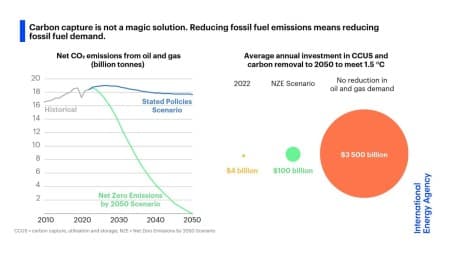
Regardless of the relative strengths and weaknesses of these methods, one thing that is undeniable about carbon dioxide removal is that its impact will take decades to be felt. Even if global emissions were to stop rising today (which they aren’t on track to do), the gap between annual emissions and the amount of carbon dioxide being sequestered each year would remain enormous.
By comparison, solar radiation management could have a dramatic and rapid effect on global temperatures, making it both more exciting and more controversial as a form of geoengineering.
Solar Radiation Management
Solar radiation management was recently described by the UN Environment Programme (UNEP) as “the only known approach that could be used to cool the Earth within a few years”. It has the potential to be both far cheaper and far faster acting than any CDR method.
At the same time, critics warn of the unknown side effects of ‘playing god’ in such a way, and note that it would be impossible to predict the knock-on effect of such a dramatic change in such a large system. These concerns led UNEP to conclude that the deployment of SRM technology is “not currently warranted and would be unwise”. Despite that conclusion, the report suggests the approach needs to be better understood and that further scientific assessments would be valuable.
Here is a brief overview of the most popular SRM techniques.
Stratospheric aerosol injection
Stratospheric aerosol injections involve spraying aerosols high up into the stratosphere to mimic the cooling effect of large volcanic eruptions. These aerosols, such as sulfur dioxide, combine with water to form sulfuric acid aerosols, which reflect incoming sunlight. Proposed methods include using planes or high-altitude balloons to release aerosols, a process that would have to be repeated every year or two to maintain the effect.
While the science is fairly clear that this approach would lead to a reduction in global temperatures, there are multiple concerns about the real-world implications of implementing it. The first problem is that there is no way to control where the particles would go after being released, with the possibility that they would all accumulate in one area or hemisphere. If that were to happen, rain patterns could be altered, leading to droughts or floods.
A second problem with this approach is that there is no way to test its effect in a small experiment. The only way to test this method would be to run it at a global scale, and even then there would be no way in the short term to establish the difference between its effect and natural fluctuations in the weather.
If the world did agree to a global aerosol injection experiment, if the earth then cooled in the desired way, and if there were no negative side-effects at all, one major question would then immediately present itself. Who gets to control the Earth’s temperature? Inject slightly more or slightly less and harvests in one region might soar or new trade routes in other regions could open up.
Finally, there is the “termination shock” problem. As SRM techniques do not lower the amount of carbon dioxide in the atmosphere, if aerosol injections were to stop then the Earth’s temperature would rapidly rebound.
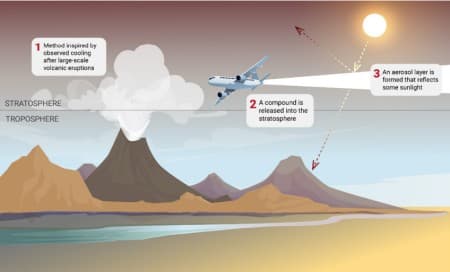
Source: UNEP Report
Of all the SRM methods, aerosol injection is the one with the potential to most dramatically and rapidly lower global temperatures. For that reason, scientists and entrepreneurs are already pushing ahead with new research and projects. Some projects, such as the SCoPEx experiment, which is designed to better understand how aerosols alter stratospheric chemistry, are working to further develop our understanding of this method. Others, like the efforts of controversial startup Make Sunsets, are already launching sulfur balloons into the stratosphere in the hope they will cool the earth. It’s perhaps not surprising that calls for regulation and international cooperation in this area are growing louder.
Marine cloud brightening
This technique aims to brighten marine clouds, the lowest clouds in the sky, by using ships to spray saltwater (or potentially other particles) into them. The salt particles would act as cloud condensation nuclei, increasing the number of droplets in the cloud which, in turn, would increase the albedo or reflectivity of the cloud. With more reflective clouds, more solar radiation is then redirected back into space.
Interestingly, what can be seen as a cloud-brightening experiment has been taking place in shipping channels around the world for years. The aerosol particles released from ship exhausts into stratocumulus clouds have resulted in an observable brightening of clouds that can be seen in ‘ship tracks’. The recent implementation by the IMO of regulations designed to lower air pollution from shipping has reduced this cloud-brightening effect and has potentially resulted in additional global warming.
One of the key concerns of marine cloud brightening is that it could alter rain patterns, although its effect is likely to be smaller than that of stratospheric aerosol injection. New research suggests cloud brightening might even be case-specific, with the effect altered by the cloud itself and by the size of the particles being sprayed.
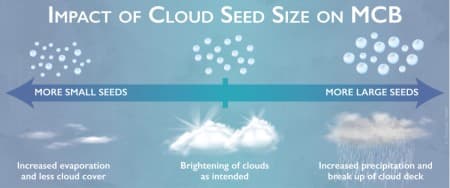
Source: NOAA Research
Currently, cloud brightening is being used in Australia in an attempt to mitigate coral bleaching on the Great Barrier Reef, and the researchers appear optimistic from the first results. Whether this could or should be used on a global scale remains to be seen.
High-albedo crops, buildings, and oceans
It isn’t just clouds that scientists are looking to boost the albedo of, there is also research into increasing the reflectivity of crops, buildings, and the ocean. Higher albedo surfaces will reflect more light, meaning the air near those surfaces will be cooler. The Earth’s average albedo (with 1 meaning all sunlight is absorbed and 0 meaning all sunlight is reflected) is 0.3, which means it reflects about 30% of the solar radiation that reaches it.
While surfaces like snow and ice have high albedos of 0.7. or 0.8, forests will absorb a majority of the light that reaches them – with an albedo of 0.15. This was touched on above as a potential downside to afforestation. Urban areas, meanwhile, can have different albedos depending on the material used.
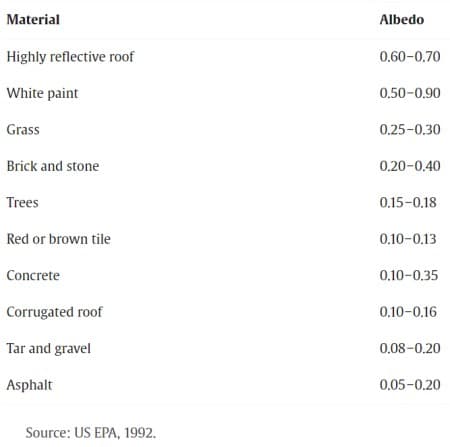
For farmland, increasing albedo involves either selecting more reflective crops or introducing genes that give plants a waxy sheen. In cities and towns, painting rooftops with light colors or using reflective material will decrease albedo and has been shown to influence temperatures.
When it comes to altering the albedo of the ocean, potential methods include dispersing microbubbles in the ocean, increasing ocean foams, and altering the chemistry of ship’s wakes to make them last longer.
While lowering albedo has been seen to have an effect on microclimates, its global impact on temperatures remains unclear. For cities in warm areas, projects designed to lower albedo can both reduce the threat of heat waves and lower energy consumption. When it comes to high-albedo crops, the potential side effects on crop productivity need to be carefully considered as well as any broader impact on local ecosystems. Similarly, the impact of increasing ocean albedo could alter marine ecosystems, especially as it could reduce light penetration and hinder photosynthesis in marine plants.
Cloud thinning
The penultimate SRM technique on this list, cloud thinning would take place below stratospheric injections and above marine cloud brightening. It aims to reduce the warming effect of cirrus clouds, which trap heat. By injecting solid aerosol particles, such as desert dust or pollen, into these clouds, these clouds would dissipate more quickly, allowing more solar heat to escape into space. The difference between cloud thinning, cloud brightening, and aerosol injection can be seen in the diagram below.
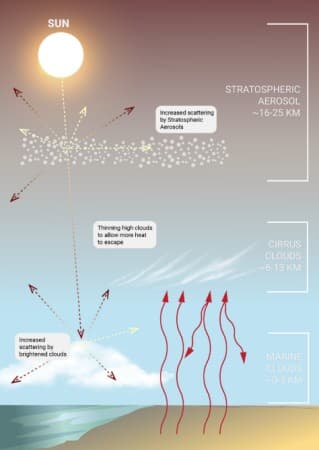
Source: UNEP Report
While this approach has been studied in climate model simulations and theoretical analysis, there have been no notable outdoor field experiments recorded. The feasibility of this approach is uncertain due to a lack of knowledge of how particles would react in high clouds.
As with other SRM approaches, cloud thinning has the potential to alter precipitation patterns and regional temperatures. There is also the possibility that it would result in more solar radiation reaching the earth’s surface. More research is needed to be sure of the feasibility of this approach.
Space sunshades
Saving the most dramatic SRM method for last, developing a space sunshade would involve launching a giant mirror into orbit to reflect away sunlight before it enters the atmosphere. The ideal place for this mirror has already been established as the L1 Lagrange point. This is a point in space where the solar radiation pressure and gravity of the Earth and the Sun are in balance. Unfortunately, to work in this area the sunshade would need a minimum surface density well above what would be plausible.

Recently, a scientist came up with a method that would dramatically reduce the mass required for a space sunshade in the L1 Lagrange point to work. This new plan involves counterbalancing the sunshade by tethering it to an asteroid or moondust. This approach would reduce the necessary mass of the sunshade leaving Earth to just 35,000 metric tons.
While theoretically effective, the technological challenges, lead time, and the need for ongoing adjustments would make this the most complex and expensive option. Even if those problems were to be overcome, the question of governance would once again raise its head.
Is It Time To Embrace Geoengineering?
In many ways, the debate around geoengineering has parallels to that of artificial intelligence. Defusing both the hype and hysteria around this topic will be critical to any effective implementation effort. On the one hand, the idea that geoengineering can do all the heavy lifting when it comes to emissions reduction is both unproductive and unrealistic. On the other hand, ignoring or unilaterally banning these technologies and approaches would be both ineffective and unwise.
As touched on above, carbon dioxide removal has largely gone mainstream and, while its effectiveness may be questioned, there seems to be little reason why most of these methods shouldn’t continue to be pursued. Critically, they should be used in conjunction with emissions reduction rather than in lieu of any emissions reduction efforts, with each project analyzed for its net impact on emissions. Ocean geoengineering is perhaps the most controversial of this category, requiring further research, global cooperation, and stringent regulation.
When it comes to solar radiation management, the rapid and global nature of its potential impact should be reason enough to pause its immediate deployment. With that said, its unique potential to cool the Earth in a short time frame justifies further research, investment, and international cooperation.
In answer to the question, then, embrace might be too strong a word, but geoengineering certainly isn’t something we can afford to ignore. The degree to which we will need or use different methods in the future remains unclear, but without proactive investment, preparation, and regulation, we simply won’t have the option.


Anybody with eyes not glued to digital screens who studies the sky knows that “Stratospheric aerosol injections involve spraying aerosols high up into the stratosphere” has been happening for a long time. Anyone who knows the name Dane Wigington and the organization that he runs, has ample independent third party validation proving that experimentation with this is ongoing.
Since my work entails analysis of commercial airline routes, I know for a fact that what I’m seeing when I look up and study the sky is not related to commercial airline traffic and I don’t need to rely on a website to tell me what I can surmise, my eyes and basic critical thinking skills tell the truth, I don’t have to rely on it being printed by some authoritative magazine or news report, I don’t need to rely on consensus opinion, and am willing to suffer slings and arrows of friends and family when ostracized as some “conspiracy theorist”
I should not have let your comment through because your anecdata is poorly informed.
There are now as many private jet flights as commercial jet flights.
Private jets can and normally do fly at higher altitudes than commercial, several thousand to ten thousand.
Commercial airliners typically cruise at altitudes of 9–12 km (30,000–39,000 ft) which is in the lower reaches of the stratosphere in temperate latitudes.
So you are not only missing half the relevant universe, you are missing the greater % of planes that go into the stratosphere.
Below are two main sites I use for commercial route analysis. Private jets? Possibly. But if they are changing the early morning blue sky to a pale white one, as I often observe, they should be outlawed on aesthetic reasons alone.
https://www.oag.com/
https://www.iata.org/
I agree completely re private jets.
But I see the color change that much many days here on a coastal town. Lots of conflating factors.
I see something “unusal” regularly now. Some jets flying over have an exhaust trail that quickly evaporates into the atmosphere, there’s a short trail that follows behind the jet. Some jets leave a long, long, long trail that doesn’t evaporate but hangs the atmosphere for some time, then slowly spreads out and joins other like trails. The long trails will abruptly start behind a jet and then as abruptly stop while the jet flys on leaving only a regular trail. I don’t know what it is, but it seems new.
“If a contrail forms behind a plane, it may last just seconds before dissipating, or it can last hours. It all depends on the atmospheric conditions at the time, according to the EPA; lower humidity leads to short-lived contrails, while higher humidity leads to persistent contrails. In the latter case, contrails may then be spread out by the wind, reaching a few miles wide and 650 to 1,300 feet (200 to 400 m) high.”
https://www.space.com/what-are-contrails
As far as I can remember from my training, small differences in atmospheric conditions at aircraft altitude can make big differences in contrail appearance. Can also be the crucial difference as to whether contrails appear or not. For this reason, contrails are uncommon in some parts of the world.
Geoengineering is inevitable because most of the world’s people will not tolerate the international inequalities dictated by uneven limits to fossil fuel consumption. There is no other way to avert climate catastrophe. The cooperation necessary to execute geoengineering projects may also put an end to the belligerent shenanigans of the Washington blob. This is an intelligence test for humanity. Let’s hope we pass.
There Is No Alternative?
I hope we don’t pass.
Geoengineering may be inevitable as you say, but it’s the wrong choice. The real intelligence test is whether we can recognize and come into harmony with our environment.
That of course won’t happen because we are expansionary organisms, so off to the fantasy of geoengineering we go! Don’t worry everybody, life can continue on as normal for just a little longer.
Remember back in 2020 when covid was the surprise quiz and climate change was to be the final? If my memory serves me well, this analogy was served up in comments quite a bit during the onset of the pandemic. Well, we didn’t do very well on the surprise quiz did we, and we seem to be skipping the final.
International cooperation will not be needed. The United States and its vassals will dictate how geoengineering unfolds. Do as we say or you will be sanctioned.
Welll . . . you knowww…
China is too powerful to be an American vassal and if the ChinaGov decides to do some geo-engineering, there won’t be a thing the US can do about it.
The intelligence test is recognising that we don’t understand chaotic-equilibrium-based mostly-hidden systems like global carbon movement well enough to mess with them.
We’re going to be jamming forks into toasters, on a global scale, because we have *not* passed the test.
See also: much modern pharmacology.
That’s putting the cart before the horse. It’s far more likely to be used as a tool for entrenching inequality and ensuring wealthy nations (with the resources to fund geoengineering projects) get to make choices that benefit them at the cost of all others.
If we aren’t capable of international cooperation and intelligence, then high tech, global impact geoengineering options like aerosol injection are likely to be a disaster. If we are, then there are many easier ways to tackle the problem.
Attempts to tamper with the ocean-atmosphere system (for example through stratospheric aerosol injection or ocean geoengineering) will almost certainly result in unforeseen side-effects. This is simply because the ocean-atmospheric system is highly complex and only partly understood. As I like to say: the more we learn, the more we realise how little we actually understand. Anyone who refuses to acknowledge this very basic precautionary principle should not be allowed anywhere near the levers of power in society. But I can’t say I’m terribly optimistic in this regard. Over the last few decades we appear to have been deliberately promoting/selecting risk-takers into leadership positions.
Playing God usually doesn’t end well.
But we’ve already been doing that since the beginning of the industrial revolution so the question is whether we can do it in a more intelligent way.
And it is a question as the above interesting article highlights.
The problem for those who want to turn back the clock and idolize the “indigenous” lifestyle is: what we are going to do with all those billions of humans who have also come along since the industrial revolution? The “let there be blood” Biden foreign policy is one approach to reducing humans but one that risks the ultimate geoengineering of an atomic war.
Science caused our AGW problem and the anti-science people are just going to have to suck it up because science will be the only way out. Yes reducing gratuitous energy waste will make a dent but may be counteracted as developing countries become greater energy users via all those people. In recent years of this very long debate it has almost seemed as though AGW virtue signaling is merely distracting from the problem by pretending that something serious is being done about it.
In any case thanks for the above which was worthwhile and thorough.
There’s a difference between using science and using technology though. For example, if a given person is responsible for a certain amount of carbon release, a couple can reduce future carbon releases by having fewer children. If we were able to cooperate voluntarily so that the majority of couples had only one child for a couple generations, we could halve the world’s population in 50 years or so. To me that’s still using science(math, logic, reasoning), but with no technology required.
We won’t do that though, so when we get to the point of using technology to screw around with geothermal energy, I can only hope that any ensuing catastrophic eruptions don’t take out the part of the continent I live on. Or maybe I’d be better off if they did. I hear global winter isn’t all that pleasant…
Just because “science” broke something doesn’t mean that “science” can put things back together and in good working order. The probability of this outcome is extremely small.
Let’s not forget that there’s on ongoing war on science. It may be easily observed in any theater where profits are involved.
Yes, NYMutza. That’s why this article reminds me of ‘The Sorcerers Apprentice’. Some of these ideas are positively terrifying.
” grinding up rocks . . . into dust and spreading it across . . . even the surface of the sea”. How is that going to affect marine life? I realise that minerals are blown into the sea every day, but would the quantities be in any way comparable? And specifically how would ‘Olivine’ (for example) in large quantities affect marine life? Similar doubts can be attached to many, if not all, of these ‘solutions’.
From an academic perspective, this is a good roundup. Sadly, the tone suggests we have years to conduct research, suss out the bugs, and proceed, while in reality even the most skeptical among us will likely be begging for geoengineering in the very near future. More sadly, we will have no international collaboration, leaving nations to act or not act individually. The intentional detonating of volcanos is gonna happen, (because Hollywood endings are real!) because that’s all we’re going to have.
My geoengineering idea is to release millions of white lobster buoys onto the Arctic Ocean to try to keep the water temperature from breaking the seafloor methane tipping point.
‘Ocean geoengineering is the attempt to boost the ocean’s capacity to hold carbon through one of two methods. The first method involves cultivating ocean life to increase the amount of carbon that ultimately ends up in ocean forests or on the seafloor. The second method involves altering the composition of the ocean itself so that the seawater can hold more carbon.’
This section really sets me on edge. This is how an accountant would look at things. That it is a matter of debits and credits and you only have to change the ratio to get the right balance. The natural world is not like that and has such things as feedback loops which can change things radically and unexpectedly. It works by chaos theory and is not a linear way of operating. You alter that composition and you may find yourself with a runaway effect that may have global implications and it may take on a life of its own whose results will show up in all sorts of unexpected places. If you asking me for specifics, I can’t tell you. Nobody can because nobody really knows. All I know is that it would be safer juggling forty year-old sticks of sweaty dynamite.
I know. The ocean has already absorbed a lot of carbon leading to acidification.
https://www.noaa.gov/education/resource-collections/ocean-coasts/ocean-acidification
How does this affect marine life?
Corals are affected as follows:
https://new.nsf.gov/news/scientists-pinpoint-how-ocean-acidification
Then there’s the new understanding that the ocean “exhales” carbon as well as absorbing carbon. The rate of each can change and no one knows why.
https://earthobservatory.nasa.gov/features/OceanCarbon
I’m starting to wonder if some of our scientists have gone mad and are as much a danger to life on earth as they claim about CO2.
Based on my personal anecdotal experience, this is true. Although, they would fervently deny being mad – probably say something about being “realistic” or avoiding doomerism.
This. Scientists are as much prey to the cult of optimism as anyone else, and it affects their predictive capacity. Have observed this myself in my recent foray into science, particularly obviously in relation to covid response.
No worries, we won’t need scientists when we have AI.
Oh yeah, pretty much every possible geoengineering play comes with a heavy dose of potentially going sideways. The punchline is we will be going down this road and soon. Good luck everybody.
The author could at least get the definition of albedo right. From the same website he’s quoting:
.
“Albedo is measured on a scale from 0 to 1. 0 is when a surface absorbs all light and reflects none and 1 is when a surface reflects all light and absorbs none.”
I think some of the passive things need implementation (passive = reflective painted surfaces, increased point of use energy absorption like solar and less energy intensive movement of energy like ground source heat pump) and some things ought to be avoided like poking with stick at a hungry tiger – altering clouds and global heat gain via super small and hard scalable after release methods.
What I don’t hear about – given the high accolades our financial geniuses always advertise – they do God’s work after all – (we have software engineering, AI, geoengineering….) why is their nothing about deploying these high priests of financial engineering to the task of creating the economic framework that would direct resources to this task of making our only spacecraft healthy and bio-diverse.
Again – if you accept the ‘survival of the fittest’ instead of IMHO, the survival of the most well adapted – then we will prove that we are neither fit or adapted
This stuff is fun to speculate on.
I remember studying space deployments in College 45 years ago (at the time it was to capture solar energy and beam it to earth – this was following the OPEC oil crisis).
These are interesting concepts none of which are going to ever happen at a scale to make any appreciable difference.
May as well hope that magic unicorns are going to eat the CO2 and crap out gold bars.
I suspect the interest in geoengineering is indeed motivated by plans to create and monetize magic unicorns which can be sold and heavily marketed for their imagined capacities for eating CO2. The Market will guarantee that the magic unicorns can crap out gold bars as part of some government underwritten Green New Deal program. If the unicorns fail in their quest against CO2, it will not matter — profits will be enjoyed and IBGYBG, so who cares about the climate.
If previous behaviour predicts future behaviour, personally I believe you are 100% correct. Because “profit”….
IMO Earl is correct. The opportunity costs of all the listed “non-passive” geoengineering schemes listed above are prohibitive, especially the time constraints. The idea that “renewables” can power the enormously energy intensive carbon capture & storage is absurd (as is the idea that renewables can fuel a continuation of BAU). The ecological uncertainties of proposals to use the atmosphere & oceans to mitigate AGW should make them nonstarters.
This paper, despite some very minor demurrals at the end, seems to me to be an exercise in wishful thinking.
“Faustian Culture” indeed.
Future USA: “Nice rainy season you’ve got there, India. Shame if something happened to it…”
Imagine the wet dreams of the elite, literally turning entire nations into deserts.
As much as Humankind knows about the Earth’s climate — even as modeled in the best IPCC models — geoengineering seems as practical and wise as placing faith in car repairs implemented by a room full of playful monkeys working under the hood equipped with hammers, hand saws, and a few power tools.
I believe geoengineering methods that rely on large inputs of energy and/or sources of refined materials will be especially fraught as fossil fuels and other resources near their points of exhaustion. A geoengineering method that worked — somewhat — for a while, but had to be suddenly curtained, would add to the instability of the transition to a new climate. Besides, many of the geoengineering concepts described in this post would likely introduce undesirable side effects like so many of the bitter pills Big Pharma produces. Playing with geoengineering — as the climate approaches a nexus of possible tipping points with potential for run-away impacts — seems especially unwise. For example the recent changes requiring ocean shipping to use lower suffer fuel oils played a role in the increasing rate of the Earth’s temperature increases — ref ““A Miracle Will Occur” Is Not Sensible Climate Policy”, p. 3, 07 DEC 2023 Communication, https://www.columbia.edu/~jeh1/mailings/
This is pretty much the behavior of an addict, is it not? We’ll endure acid rain and Bill Gates charging the world for his spraying sulfur in the sky every two years as opposed to reducing our carbon footprints. Or put more concretely, we’ll risk making the Earth truly unlivable for the sake of that big pick up or the trip to Aruba in February.
Bernays has had his way with us so thoroughly that we can’t face reality and simple truths. Now we have Bernays on steroids with Zuck and Musk and the human programmers. Grace Slick had a warning 50 years ago about people who mess with people’s brains and endocrine system for the sake of materialism and profit:
May it be true along with Grace’ promise at the end of “Greasy Heart:
“Greasy Heart” by Grace Slick; Jefferson Airplane
The main argument against geoengineering is that we would be tampering with a complex system. The main argument for geoengineering is that we are already tampering with that system so what have we got to lose? To which the opponents say “well, why don’t we just reduce consumption”?
While reducing consumption would undoubtedly be the sane thing for humans to do, implementing such a program globally requires intercultural cooperation at a time of reduced resource availability, which is not, historically, a strength of humanity. Particularly when exploitation of those resources confers a sizeable military advantage.
We may be the Old Lady Who Swallowed A Fly, but having swallowed the fly I’m not sure we have a better choice but to swallow the spider as well…
I do hope though, that if/when we get desperate enough to try geoengineering on a massive scale, we will choose methods that we are sure will not have a negative impact on human health. Some of these options are, I think, more risky in this regard than others. Sulfur dioxide is associated with asthma. And I have read that cool roofs (that is the name given to reflective roofs) can cause mold problems. Perhaps it is a problem fixable with proper air sealing between the living space and the attic, but that won’t be something any roofer will do–and thus something they aren’t likely to mention, as it increases the overall price tag of cool roofs without providing the roofer with any more business.
And I will add that not all interventions in complex systems end badly. The human body is a complex system, yet we have, over time, managed to find ways to intervene when things go wrong. Of course many interventions fail, or create a new normal that is less desirable than the earlier state of health. But some interventions are entirely successful in returning a body back to equilibrium.
As with medicine I think we would be well served by eschewing treatments made popular because of their commercial (grift) potential, and instead focusing on simpler approaches. But ultimately only experimenting will tell us what will be successful, and what side effects we can expect.
Of course we would have no knowledge of AGW if not for science so it’s a bit inconsistent for the advocates to denounce “science deniers” for preventing a solution while themselves denouncing other scientists who may–possibly–know what they are doing when it comes to a geoengineering solution. Perhaps the correct conclusion is that we need a lot more science and a lot less rhetoric. Al Gore’s message would have had a better impact if not from Al Gore who was not even very trustworthy as a politician.
So in that sense you can’t necessarily blame the drivers of those giant pickup trucks for making up their own truth. Happens all the time these days and from the “nicest” people.
Ultimately facts on the ground will probably have to drive whatever happens. We are getting some of that already but just some so far. The elites in general these days have a credibility problem.
“…other scientists who may–possibly–know what they are doing when it comes to a geoengineering solution.”
Who are these scientists you are talking about? How could they possibly know what they are doing when it comes to geoengineering? [I excluded the word “solution” from your statement as tending to beg the question.] Geoengineering is not Science and it is not engineering. The Earth’s climate is not a Tacoma Narrows Bridge we can rebuild if some geoengineer is unaware of, or fails to take into account little things like the resonant frequency of the bridge and the frequency of the disturbances the winds have on the bridge.
“The main argument against geoengineering is that we would be tampering with a complex system. The main argument for geoengineering is that we are already tampering with that system so what have we got to lose?”
We did not arrive at the problem of climate change by “tampering” with a complex system. Our present situation resulted through long term denial of some side effects of our burning fossil fuels for energy rather than what might be called tampering. From tampering you move to the word “intervention” in your extending comment, another word that suggests some degree of intention as well as at least some modest degree of knowledge about the impacts of an action. In using “intervention” you compare medical actions to treat disease with geoengineering to treat climate change. It is true that medical interventions like geoengineering can have unknown side effects, that could kill or greatly harm the patient, but beyond that the comparison fails. Modern medical interventions have typically undergone rigorous trials in the treatment of animal subjects and human volunteers — numerous experiments — to identify side effects and their likelihoods. In the case of climate change, there is only one patient, and the geoengineering interventions have not and really cannot be tested through rigorous trials of their application to many Earths to identify and characterize side effects.
The systems of the human body are indeed complex and so are the Earth’s climate systems — however I believe there are significant differences. The systems of the human body work diligently to maintain the life of the body. I do not believe the Earth’s climate systems have any preference for maintaining the pleasant climate Humankind had enjoyed for the last ten-thousand years.
“But ultimately only experimenting will tell us what will be successful, and what side effects we can expect.”
We can experiment with climate models to test what results a geoengineering project might accomplish and what side effects it might incur. The best knowledge we have about paleoclimate strongly suggests there are many components of the Earth’s climate we know nothing about. Past climate transitions have been very “exciting” in most unpleasant ways.
The human body is a complex system, yet we have, over time, managed to find ways to intervene when things go wrong. Of course many interventions fail, or create a new normal that is less desirable than the earlier state of health. But some interventions are entirely successful in returning a body back to equilibrium.
The bit you’ve failed to connect here is that we learnt medicine by irretrievably taking humans apart on purpose, and by killing a whole bunch more with incorrect interventions. We don’t have a planet B, as they say, and that’s where analogies from medicine and engineering experience fall down.
“Tinkering until we find a solution that works” is most likely to irretrievably end our tinkering before we find a solution. Odds seem about as good as natural selection.
To your point and also Greg’s: I agree that in the case of geoengineering we have but one patient, which does complicate things as we don’t have the luxury of “killing a bunch of patients” when we experiment. On the other hand, we also don’t have to worry about whether the results we get from said experiment will be generalizeable to other planets, which is a major reason that we do trials the way that we do.
The plus of having only one patient desperate enough to experiment is that the patient can simply start with a low dose and work their way up if they see benefits. With a single patient there isn’t even a need to make sure that success is not due to random chance because improvement is improvement, and there’s no need to know if it will work for another patient.
Of course we (mostly) only do this with drugs known to be relatively safe at the prescribed dose. Most drugs will give a warning in the form of unpleasant side effects before they do irreparable harm. Not all. But most drugs most of the time. And although we haven’t tested any of these geoengineering schemes on a large scale, I bet some smart people could come up with a riskiness scale for the various interventions. At least some of those risks could be investigated before we do large-scale implementation.
I think most people here will agree that business as usual is driving us off a cliff. The question then, as I see it, is whether it is plausible to drastically reduce emissions worldwide. I am suggesting there are very few major powers willing or able to reduce fossil fuel dependence if it harms military readiness, and that those who are willing to make that sacrifice will find themselves at the mercy of those who do not (witness the deindustrialization of Germany).
We generally allow terminally ill patients to try experimental treatments because again, what have they got to lose? Frankly I see human-habitable earth in a similar way at this point. And I think that the sooner we acknowledge that there is good reason that governments are generally unwilling to cut back on fossil fuel use in a major way, the more time we will have to experiment in a more conservative way.
PS For what it is worth, when I was talking about experimenting with medicine, I was thinking more of what must have gone into developing holistic medicine like Chinese medicine. In many cases herbs are less potent and also less dangerous than western drugs. So there’s more leeway in terms of experimentation. More room to get things wrong without dire consequences.
“Perhaps it is a problem fixable with proper air sealing between the living space and the attic, but that won’t be something any roofer will do–and thus something they aren’t likely to mention, as it increases the overall price tag of cool roofs without providing the roofer with any more business.”
As always – a properly designed installation of the roof component of the building envelope is easily achieved and presents no additional costs or difficulties to a competent roofing contractor – and a cool roof -even re-roof – does not cause mold problems. In my long experience.. mold problems are the result of errors of install (most), design (a little) or lack of the most minimal maintenance.
Retrofitting an existing building to massively reduce energy use is expensive but that compared to increases in the housing market due to speculative gains is less expensive by far.
To build a new unit to net zero would perhaps add 5% to overall construction costs – it just is not done because the available materials and supply chains are slow to develop in the building trades, an unwilling-ness to change the old ways – Just my two cents – maybe it is worth just that LOL
Our response to the Climate Crisis has been spelled out by Naomi Klein.
“Shock tactics follow a clear pattern: wait for a crisis (or even, in some instances, as in Chile or Russia, help foment one), declare a moment of what is sometimes called “extraordinary politics”, suspend some or all democratic norms – and then ram the corporate wishlist through as quickly as possible.”
The Oligarchs have been holding off any real response to the Climate Crisis with a world-wide disinformation campaign that ‘there is nothing to see here’ for several decades. Soon, after waiting for the crisis to intensify, they will declare the moment for “extraordinary politics”. The corporate wishlist of climate solutions will then be pushed through.
Their solutions will have nothing to do with efficiency but everything to do with profits and extending corporate control. At least in the West. Our only hope is that the East and the rest of the world will act more rationally.
Amen.
Isn’t “enhanced oil recovery” just another form of fracking?
Not really. The old fields of the Permian have been undergoing “enhanced” recovery for 50 years. First, came “water flood” which injected water under pressure to retrieve another 10-15% after initial recover left 85% of the oil in the ground. After that, CO2 under pressure is applied as “tertiary recovery.” The CO2 increases the “miscibility,” i.e. the slipperiness of the oil so that more of the remaining oil comes out.
The first experiments in tertiary recovery used CO2 recovered from a natural gas power plant in Texas. Once proven feasible, Shell and Mobil built a pipeline from Cortez, CO to Denver City, Texas to bring CO2 from a naturally occurring deposit called the McElmo Dome to Shell’s Hobbs Unit in the Permian that had already undergone water flood. This was in 1981. Amoco did the same taking CO2 from the Bravo Dome located in NE New Mexico.
My guess is that the end of the naturally occurring CO2 in these deposits is in sight, and the oil companies see direct air capture as a way to keep up the supply of CO2 for tertiary recovery. After all, that’s where the CO2 came from for initial testing, so it just needs to be brought up to scale.
No chemicals injected into the ground other than CO2. No deep formations. Only in wells drilled long ago.
The harm comes not from the method but from the extra oil recovered. With fracking, it’s both.
Why is regenerative farming (or regenerative agriculture) not on the list for sequestering carbon? It is the most cost effective method of carbon sequestration by creating a living soil — and has the added benefits of requiring less water for agriculture, less fertilizer, less pesticides, less pollution to ground water, and can do away with GMO monocrops. Oh wait — those added benefits would hurt agribusiness. No wonder it was not mentioned. Capital must rule — monopoly agribusiness must rule the day.
No solution will be tried that cannot make our billionaires richer.
To be honest, I have yet to find a study that convincingly proves “carbon sequestration” in natural systems is a long term solution of any sort.
Regenerative agriculture is an important first step, because among other things it drastically reduces fossil fuel and energy requirements, but the carbon sequestration benefits are a one time bump to storage that won’t make a difference to the multi-year trend.
From what I’ve read, no natural system that we’ve studied permanently stores carbon, and the long term storages are all geological not biological. Biology cycles relatively fast – good estimates I’ve seen are about 15 years. So we can increase storage capacity of agriculture, but it’s short term storage and not “sequestration”. The reduction in carbon generation at the front end of regenerative practices are going to be more consequential.
Has anyone studied carbon sequestration in wetlands to see how long term it is and how much it stores? Peatlands, etc.?
There were several funny sayings when stupid communists ruled Eastern Europe. 1/ We will force wind and rain to do what we want 2/ Annual state economic plan will be fulfiled even if there is nothing left to bake bread. These times are coming back but communists now wear green coats.
I’ve never been particularly bright so I may have read this post incorrectly and need a little help.
It talks about developing sunshades. Yet, all I hear all the time is solar, solar, solar and more solar as part of the renewable package. We have solar trackers, love it. Wouldn’t “sunshades” reduce the effectiveness of solar panels everywhere?
And for Chri$ts sake, why don’t we just stop half the warmaking going on around the world. Wouldn’t that be a huge first step to reducing emissions?
I would embraced afforestation and reforestation, banning of deforestation, limiting population growth, limiting consumption.
It’s really quite simple. We are pumping carbon (which is buried sunlight) into an atmosphere which is only 10km (6 miles) deep. What could possibly go wrong?
Any solution which advocates for more pumping of carbon into the atmosphere is not likely to cut it. It is magical thinking. And almost certainly involves a lot of marketing/green washing.
If this does not convince you, refer to the basic laws of economics, sorry thermodynamics /heavy sarcasm
I thought this was interesting, if speculative at this time:
https://news.stanford.edu/2019/10/17/new-catalyst-helps-turn-carbon-dioxide-fuel/
https://penntoday.upenn.edu/news/closing-carbon-cycle-green-propane-production
We humans need to figure out how to live without using such enormous amounts of polluting energy sources. That said, if tomorrow we figured out how to live with net zero carbon, global warming would continue apace because of the excess carbon we have dumped in the atmosphere and oceans since the Industrial Revolution; still, rather than go down a road that smells just like the processes that produced the problem, the slow and natural way is preferable to me: that would be afforestation and managing agriculture to produce healthy carbon-capturing soils. The latter change is necessary for net-zero, as our current agricultural system globally is part of the problem.
And now a short diversion from a classic American television show: The geoengineering solution to smog in Greater Los Angeles in 1970, at 7:00 into the video.
Sorry. I have always remembered this for some reason and YouTube delivered.
This line seems wrong if we look at the table below:
The Earth’s average albedo (with 1 meaning all sunlight is absorbed and 0 meaning all sunlight is reflected) is 0.3, which means it reflects about 30% of the solar radiation that reaches it.
I read recently about a most-effective-yet super-white super-reflective material which could be used on buildings and anywhere else it would be stable and non-damaged by the use happening on those “anywhere else” places.
The article is titled: ” Ultra-white ceramic cools buildings with record-high 99.6% reflectivity ”
https://newatlas.com/materials/ultra-white-ceramic-cools-buildings-record-high-reflectivity/
And things I have read in the past about the “blackest-black super light absorbers” make me wonder if those materials could be used in solar heating applications. Here is an article titled: ” MIT creates blackest black that is darker than Vantablack” . Here is the link.
https://www.dezeen.com/2019/09/24/blackest-black-mit-material-news-vantablack/
Geo-engineering is often discussed but eco-engineering is hardly ever discussed. ” Eco-engineering”? Ecosystem restoration and/or maintainance for ecosystems which suck down carbon fast and hard and keep it bio-stored for a while. Wetlands, peatlands, beaver pondlands, etc.
The role of disrupted water-cycles in driving earth-surface temperature rises which lead to heat buildups has been neglected except by a few. Here is an interesting article about the life and work of Spanish “ecosystem/land-use hydrologist” Millan Millan and his studies about deforestation in Spain and its contribution to reduced region-wide water-cycling and attendant temperature rises and other problems.
https://www.resilience.org/stories/2023-07-17/millan-millan-and-the-mystery-of-the-missing-mediterranean-storms/
Here is a talk by Millan Millan called “farm water at its proper scale”.
https://investinginregenerativeagriculture.com/2023/07/28/millan-millan/
at the bottom of the site are links to other relevant talks. If transcripts existed then the dislikers of audio and video would not have to hear/watch audios or videos. But since transcripts don’t exist, dislikers of audio and video can either listen and watch, or else they can just go without the information altogether. That is a choice that they have.
Here is a bunch of relevant images. Every image has an url where people can go url diving if they want.
https://images.search.yahoo.com/search/images;_ylt=AwrEpONBioNlAIgBaENXNyoA;_ylu=Y29sbwNiZjEEcG9zAzEEdnRpZAMEc2VjA3Nj?p=millan+millan+water+cycle&fr=sfp
Finally, it has been said above that solutions which don’t further enrich billionaires will not be permitted, tolerated or applied. But some individuals here and there have been demonstrating these approaches to their own make-a-living benefit without enriching billionaires or getting billionaire permission first. I think of people like Gabe Brown, Gary Zimmer, etc. Of course right now there are so few such people that every one of them can be named. But what are the inherent barrers to more people doing the Brown-Zimmer thing?
If enough other people taking Brown-Zimmer approaches actually motivates the billionaire class and its servants to actually try suppressing these efforts, then the concept of Class Wars of Total Extermination against every single member of the Billionaire class and every single one of its supporters and apologists may have to be attempted. Do the billionaires and the private jet set members really want to push society to that extreme?